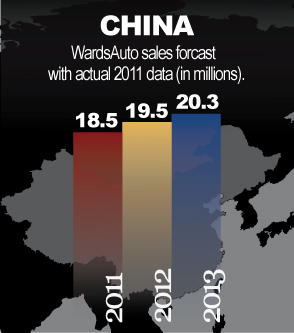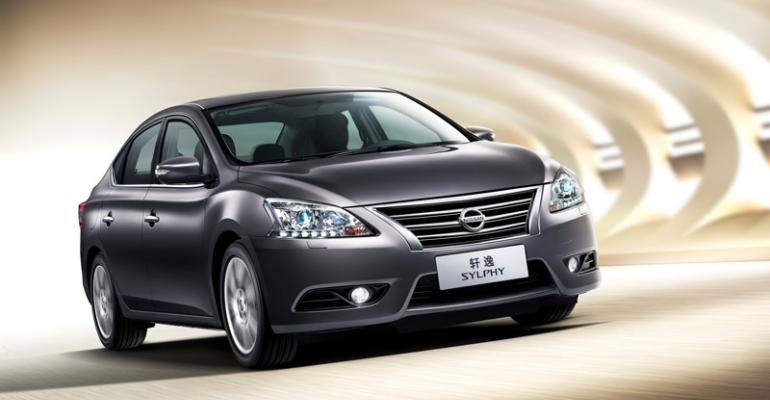With total vehicle sales up a mere 3.4% through September to 14.1 million units, compared with year-ago, and many other developing markets maintaining their momentum, it would be easy to presume China has lost its luster.
But the world’s largest vehicle market still has considerable potential for growth that should keep it in play for the foreseeable future.
“Other markets will undoubtedly see their vehicles grow faster than China in percentage terms, but in terms of growth in absolute numbers, not much can stand in the way of China for awhile,” Tim Dunne, director-global automotive operations for J.D. Power & Associates, tells WardsAuto.
Vehicle sales in China have slowed this year compared with their dizzying double-digit growth before the global recession of 2008-2009.
 This mostly is due to the phasing out of government incentives, plus China’s restrictions on the number of cars that can be registered in overcrowded urban areas and the drop in export demand as Western economies struggle with recessionary pressures.
This mostly is due to the phasing out of government incentives, plus China’s restrictions on the number of cars that can be registered in overcrowded urban areas and the drop in export demand as Western economies struggle with recessionary pressures.
That’s particularly true for the European Union, one of China’s largest trading partners. As a result, China’s own economy is softening.
However, Dunne cites relatively low vehicle ownership of 50 vehicles per 1,000 Chinese, compared with 900 per 1,000 Americans, as a key reason for the country’s likely continued steady growth. “Other markets may grab some headlines in the coming years – Indonesia and Vietnam come to mind because of their large populations, underdeveloped industries and growing economies – but China will still be the central focus of most auto makers’ attention,” he says.
Other analysts agree. “(China’s) continued GDP (gross domestic product) growth and urbanization increases the number of middle-class consumers that can afford to buy cars,” Bill Russo, president of consulting firm Synergistics, tells the Financial Times.
Such potential encourages major auto makers such as General Motors, which has said it plans to introduce more than 60 new vehicles in China over the next five years and intends to increase annual sales in the country from 2.35 million units to 5 million by 2015.
Light-vehicle sales through August, excluding imports, reached 11.7 million, WardsAuto data shows. While that’s only 6.3% ahead of prior-year’s 11.0 million, it’s 9.5 million more than were delivered in India, which was up 12.0% in the first eight months. Thailand’s sales surged 47.6% in the period to 861,951 thanks to a strong recovery from last year’s floods, but its volume is hardly in China’s ballpark.
 WardsAuto is forecasting China’s total vehicle sales to grow 5.5% to 19.5 million units for the year, an “astounding number any way you slice it,” Dunne says. But while the news is good, the vehicle mix is changing.
WardsAuto is forecasting China’s total vehicle sales to grow 5.5% to 19.5 million units for the year, an “astounding number any way you slice it,” Dunne says. But while the news is good, the vehicle mix is changing.
Despite government efforts to boost domestic brands, Chinese car buyers still are flocking to foreign models, albeit many that are built by global auto makers in the country through joint ventures. This remaking of the market could have a lasting influence.
Domestic car companies have taken a bigger hit from the market’s slowdown, Dunne says. Unable to stock dealer lots with as much inventory as their foreign-brand competitors or slash prices on vehicles due to traditionally razor-thin profit margins, deliveries have been falling.
BYD is the poster child, plunging as low as 23.3% in August, while Volvo owner Zhejiang Geely is the exception, with sales still growing.
“Chinese brands are stuck,” Dunne says. “The only lever they have to pull is further price reductions, which exposes them to potentially heavy losses. How long can they sustain the losses? No one knows for sure.”
Losses could go on indefinitely, he says, so long as local governments, the source of most domestic auto makers’ backing, continue their financial support in order to grow jobs and tax revenue.
“If you surrender the fight now, it will become very difficult to restart it later, as competitors will have become stronger,” Dunne says of provincial governments’ possible reasoning.
For the time being, American, European and Korean competitors are the domestics’ fiercest foes, as a dispute between China and Japan over ownership of a group of uninhabited islands in the East China Sea rages on.
Violent protests calling for a boycott of Japanese products have led many Japanese manufacturers to shut down their Chinese operations and close retail outlets, some of which have been damaged by arson.
Domestic auto makers in partnerships with the Japanese also are being targeted. China’s Xinhua news agency reports Dongfeng, which has joint ventures with Honda and Nissan, expects a 30% decline in September-December sales, amounting to a loss of 150,000 units.
Overall light-vehicle deliveries already are showing the effect, with September results down 0.3% to 1.32 million units, according to the Chinese Association of Automotive Manufacturers, while total vehicle sales slid 1.8% to 1.62 million.
Both Nissan, the leading Japan-based seller of new cars in China, and Mazda reported September sales falling 35% below year-ago. Toyota, which dropped 48.9%, decided to halve its October production from like-2011 levels, Japan’s Mainichi newspaper says
In comparison, Hyundai-Kia September deliveries rose 9.5% from year-ago, on track to meet the auto makers’ combined 2012 sales goal of 1.25 million units. Ford, GM and BMW also saw sales boosts. The Ford Focus was the best-selling foreign brand for the month.
Dunne believes the dip in sales for Japan brands will be relatively short-lived, as Chinese car buyers consistently have shown they favor the quality and reliability long inherent in Japanese cars. Plus a prolonged lockout would harm domestic JV partners and their provincial governments.
Nissan Executive Vice President Andy Palmer tells WardsAuto the auto maker has no plans to halt construction of a fourth manufacturing plant in the country, set to open in 2014 in the northeastern Chinese city of Dalian. Nissan has said it wants to sell 1.35 million vehicles in China this year, and he says the order rate is “starting to pick up.”
Forecaster AutomotiveCompass expects China’s light-vehicle production to reach 18.2 million units in 2012, up 6.0% from prior-year, and climb 12.6% to 20.5 million in 2013.





